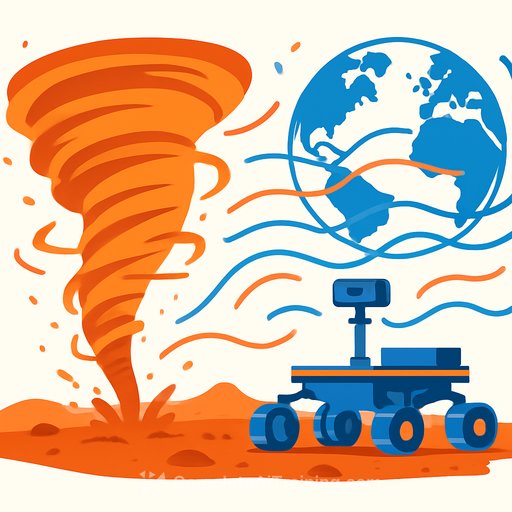Mars' Fast Near-Surface Winds Mapped by Deep Learning: Dust Devils Hit 160 km/h
Image: Dust devil sweeping across Mars. Credit: CC BY SA 3.0 IGO ESA/TGO/CaSSIS for CaSSIS
Mars looks quiet. It isn't. An international team analyzed tens of thousands of orbital images and found that dust devils-and the winds that steer them-can reach 44 m/s (about 160 km/h), far beyond earlier estimates from surface measurements.
These winds inject large amounts of fine dust into the atmosphere. That dust modulates weather, affects climate over time, and sets boundary conditions for surface processes and mission operations.
What's new
Led by Dr. Valentin Bickel (Center for Space and Habitability, University of Bern), the team used deep learning to detect dust devils in more than 50,000 images from two European cameras: CaSSIS on ESA's ExoMars Trace Gas Orbiter and HRSC on ESA's Mars Express.
From this global catalog, they used stereo image pairs-captured seconds apart-to track the motion of ~300 dust devils, extracting directions and speeds. The work, with collaborators from the University of Bern, the Open University (UK), and DLR, is published in Science Advances (8 October 2025).
How the measurements work
Dust devils are visible tracers of otherwise invisible near-surface winds. Stereo sequences provide displacement over known time intervals, turning image pairs into velocity measurements across varied terrains and seasons.
The analysis rests entirely on European Mars datasets, with CaSSIS system development led by Prof. Nicolas Thomas at the University of Bern and support from SERI's Swiss Space Office via ESA's PRODEX program.
Key results
- Wind speeds up to 44 m/s (~160 km/h) across the planet-well above prior surface-based reports (typically under 50 km/h, rarely reaching ~100 km/h).
- Strong, straight-line winds likely lift far more dust than previously assumed, intensifying the atmospheric dust load.
- Global coverage over roughly two decades enables maps of where and when conditions are sufficient for dust lifting.
Why it matters for science
More accurate wind fields improve Mars general circulation and mesoscale models. That raises confidence in simulations of dust entrainment, radiative forcing, and feedbacks that drive seasonal cycles.
The dataset also supports research on dunes, ripple migration, and slope streak activity by grounding transport thresholds with observed wind regimes.
Why it matters for missions
- Landing site selection: better risk assessment for descent, landing, and surface ops.
- Dust management: improved predictions for dust deposition/clearance on optics, radiators, and solar arrays.
- Mobility and sampling: route planning and operational windows aligned with calmer periods or known wind corridors.
As co-author Dr. Daniela Tirsch (DLR) notes, more precise wind inputs translate to sharper models of the atmosphere and surface processes-practical data engineers and mission planners can use.
What's next
The team plans coordinated CaSSIS and HRSC observations to expand the stereo time series and refine wind maps. Longer baselines and targeted campaigns will help separate regional patterns from short-term bursts.
Over time, this builds a global, time-resolved picture of near-surface winds that can guide payload design, operations, and science priorities.
Further reading
- ESA ExoMars Trace Gas Orbiter and CaSSIS
- Science Advances: Dust devil migration patterns reveal strong near-surface winds across Mars
Build the skill stack
If you work with planetary or Earth-observation data, deep learning for feature detection and motion tracking is becoming standard practice. For structured ways to level up, explore curated options here: AI courses by skill.
Your membership also unlocks:






